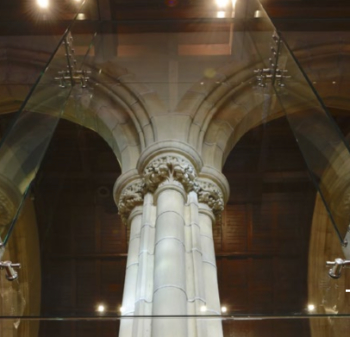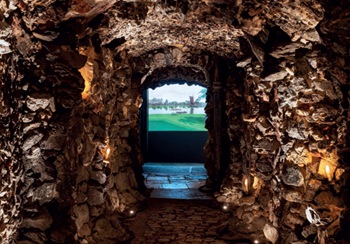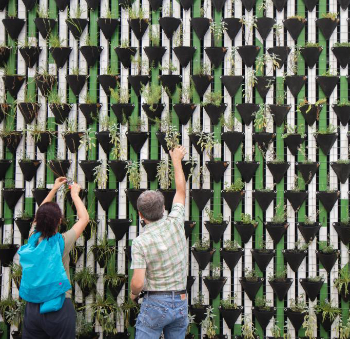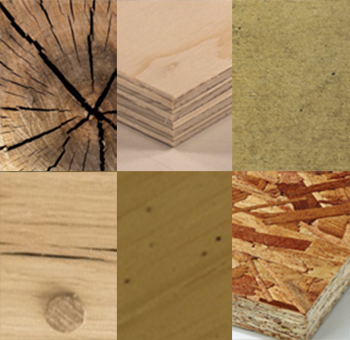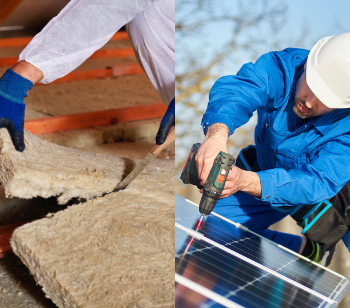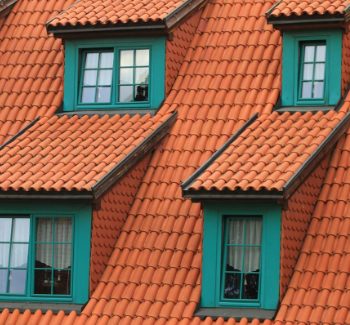Buildings made from Coal

|
| Surface coal mine in Gillette, Campbell County, Wyoming. (Reference image by Greg Goebel, Wikimedia Commons). |
[edit] The right thing for the wrong reasons?
Today there is an increasing focus on retaining stocks of sequestered carbon through the reduced burning of fossil fuels, finding new ways to sequester carbon and the use of material that not only have reduced carbon footprints in production but also actively sequester locked carbon into building fabric.
A very loose calculation for the make up of timber is around 50% carbon, 44% oxygen and 6% hydrogen; so 50 tonnes of sawn softwood timber will contain around 25 tonnes of sequestered carbon. When timber is used in the construction of a building that carbon becomes 'locked in' (rather than being burnt and released) for the lifespan of the building (though one must also consider the end of life scenario).
When coal is burned, carbon and hydrogen are released to combine with oxygen to form carbon dioxide and water. The average amount of CO₂ that would be produced for an anthracite coal 90% carbon for the weight of the coal. So there would be around 45 tonnes of carbon stored in 50 tonnes of anthracite coal. If this was burnt this would be released, if retained in the earth it would remain locked in.
Biogenic materials, such as wood operate within the bioenergy system, so the burning of biomass returns to the atmosphere the carbon that was absorbed as plants grew and can be replenished by new plants. The IPCC refer to this as the fast domain of the carbon cycle, which includes sequestration of vegetation, soil, the atmosphere and oceans, as the cycle turnover is around 1– 100 and 10– 500 years.
The slow domain of the carbon cycle, has a turnover beyond 10,000 years and includes carbon sequestered in non-biogenic materials such as coal and other fossil fuels. The burning of fossil fuels such as coal, transfers carbon from the slow domain to the fast domain, where replenishment of carbon released through natural processes cannot occur due to the time required for these processes to take place.
Although leaving coal in the ground is the most logical solution to emissions related to fossil fuels, a number of rare buildings made from coal from the height of the coal mining era do exist. In many cases these were built to promote the use of coal as a fuel, but it is interesting to consider their outcome was to sequester or lock in the carbon. The few examples are described below as well as a modern day approach to building from coal using waste products from the coal mining industry.
[edit] Williamson Coal House, West Virginia, US

|
| Adams, Nancy Ray "Williamson Coal House." e-WV: The West Virginia Encyclopedia. 28 June 2022. Web. 19 August 2022. |
The Williamson Coal House was constructed in 1933 from 65 tons of coal, and is located in downtown Williamson, in the US state of West Virginia near the state’s southern coalfields. The building was the idea of O. W. Evans, the general superintendent of the fuel mines of the Norfolk & Western Railway, mainly as a publicity stunt and it was designed by the architect H. T. Hicks.
The construction of the building was supported by local businesses and the community, the coal was donated by mining companies near Williamson, including Leckie Collieries, the Crystal Block Coal Company, Puritan Coal, the Sycamore Coal Company, and the Winifrede Block Coal Company, from the Winifrede Seam. It is made from hand-sawn blocks of bituminous coal joined with black mortar to form the rectangular structure’s four walls and two pillars and is now on the National Register of Historic Places.
The Coal House is owned by the Williamson Convention and Visitors Bureau and houses the Tug Valley Chamber of Commerce. The interior of the Coal House was severely damaged by fire on October 11, 2010. With guidance from the West Virginia Division of Culture and History, the Mingo County Commission worked to repair the structure, and the Coal House reopened to visitors on September 26, 2011.
Source: Adams, Nancy Ray "Williamson Coal House." e-WV: The West Virginia Encyclopedia. 28 June 2022. Web. 19 August 2022, see external links .
[edit] 50 tons cannel coal house in West Virginia, US

|
| https://ark.digitalcommonwealth.org/ark:/50959/6d570r76d Terms of Use: No known copyright restrictions or on use. |
Not so much is known about the background to this house but it was built in 1961 with 50 tonnes of cannel coal, and is located one mile east of White Sulphur Springs, West Virginia on Rt. 60. See external links.
[edit] Middlesboro, Kentucky Coal House, US

|
| http://nomadicnewfies.blogspot.com/2013/11/home-of-lee-majors.html |
A Coal House built in 1926 from 42 tons of coal located near the county historical museum which used to be a Carnegie library and houses an outdoor display of mining equipment from the 1960's. See external links.
[edit] The Coal House, White Sulphur Springs, East End. West Virginia

|
| Harry W. McCormack (TEABERRYEAGLE) Creative Commons Attribution 3.0 Unported license. |
A building built using 30 tons of West Virginia's anthracite coal. It was used as a gift shop where items of coal were sold such as figurines and other carvings in coal. See external links.
[edit] X-MAT modern day coal house

|
| Ceramic X-BRIX and X-MATRIX concrete blocks, both made with more than 50% coal. (Image courtesy of X-MAT, Faceboook). www.mining.com |
A house completely made out of coal is being developed by US-based company X-MAT and may be partially ready by 2023. According to the firm, which is the advanced materials division of industrial engineered materials provider sem-plastics. It has been able to perfect the bricks, blocks, facades, panels, and roof tiles that comprise all the components needed to construct the building.
After receiving a number of contracts and grants from the Department of Energy’s National Energy Technology Laboratory (NETL), the company can now rely on an additional $2.2 million from the DOE to continue the research and development of its high-strength, lightweight building materials made using domestic coal waste. For more information see external links.
The leading coal-producing state in the US, Wyoming, is now be the home of a 5,500-square-foot coal commercialization facility where companies and researchers can work on producing asphalt, graphene, graphite, agricultural char, carbon fibre, and more – using coal and coal by-products. For more information see external links.
--editor
[edit] External Links
- https://www.wvencyclopedia.org/articles/1278
- https://www.digitalcommonwealth.org/search/commonwealth:6d570r76d
- http://nomadicnewfies.blogspot.com/2013/11/home-of-lee-majors.html
- https://commons.wikimedia.org/wiki/File:THE_COAL_HOUSE_-_BUILT_WITH_30_TONS_OF_WEST_VIRGINIA_ANTHRACITE_COAL_-_IN_WHITE_SULPHUR_SPRINGS%27_EAST_END,_ON_US-60_NEAR_ENTRANCE_TO_INTERSTATE_64.jpg
- https://www.mining.com/american-company-developing-house-made-of-coal-waste/
- https://www.mining.com/innovation-center-launched-in-wyomings-carbon-valley-tasked-with-finding-new-uses-for-coal/
[edit] Related articles on Designing Buildings
- Biomass.
- Biomaterials.
- Biogenic materials.
- Brown coal.
- Can carbon sequestration in urban landscapes form part of a net-zero carbon approach to development?
- Coal ash.
- Coal tar.
- Embodied energy.
- Environmental impact of biomaterials and biomass.
- Lignite.
- Petroleum coke.
- Steam coal.
- The Coal Research Establishment.
- Types of fuel.
- Oil - a global perspective
Featured articles and news
Microcosm of biodiversity in balconies and containers
How minor design adaptations for considerable biodiversity benefit.
CIOB student competitive construction challenge Ireland
Inspiring a new wave of Irish construction professionals.
Challenges of the net zero transition in Scotland
Skills shortage and ageing workforce hampering Scottish transition to net zero.
Private rental sector, living standards and fuel poverty
Report from the NRH in partnership with Impact on Urban Health.
.Cold chain condensing units market update
Tracking the evolution of commercial refrigeration unit markets.
Attending a conservation training course, personal account
The benefits of further learning for professsionals.
Restoring Alexander Pope's grotto
The only surviving part of his villa in Twickenham.
International Women's Day 8 March, 2025
Accelerating Action for For ALL Women and Girls: Rights. Equality. Empowerment.
Lack of construction careers advice threatens housing targets
CIOB warning on Government plans to accelerate housebuilding and development.
Shelter from the storm in Ukraine
Ukraine’s architects paving the path to recovery.
BSRIA market intelligence division key appointment
Lisa Wiltshire to lead rapidly growing Market Intelligence division.
A blueprint for construction’s sustainability efforts
Practical steps to achieve the United Nations Sustainable Development Goals.
Timber in Construction Roadmap
Ambitious plans from the Government to increase the use of timber in construction.
ECA digital series unveils road to net-zero.
Retrofit and Decarbonisation framework N9 launched
Aligned with LHCPG social value strategy and the Gold Standard.
Competence framework for sustainability
In the built environment launched by CIC and the Edge.
Institute of Roofing members welcomed into CIOB
IoR members transition to CIOB membership based on individual expertise and qualifications.
Join the Building Safety Linkedin group to stay up-to-date and join the debate.
Government responds to the final Grenfell Inquiry report
A with a brief summary with reactions to their response.













